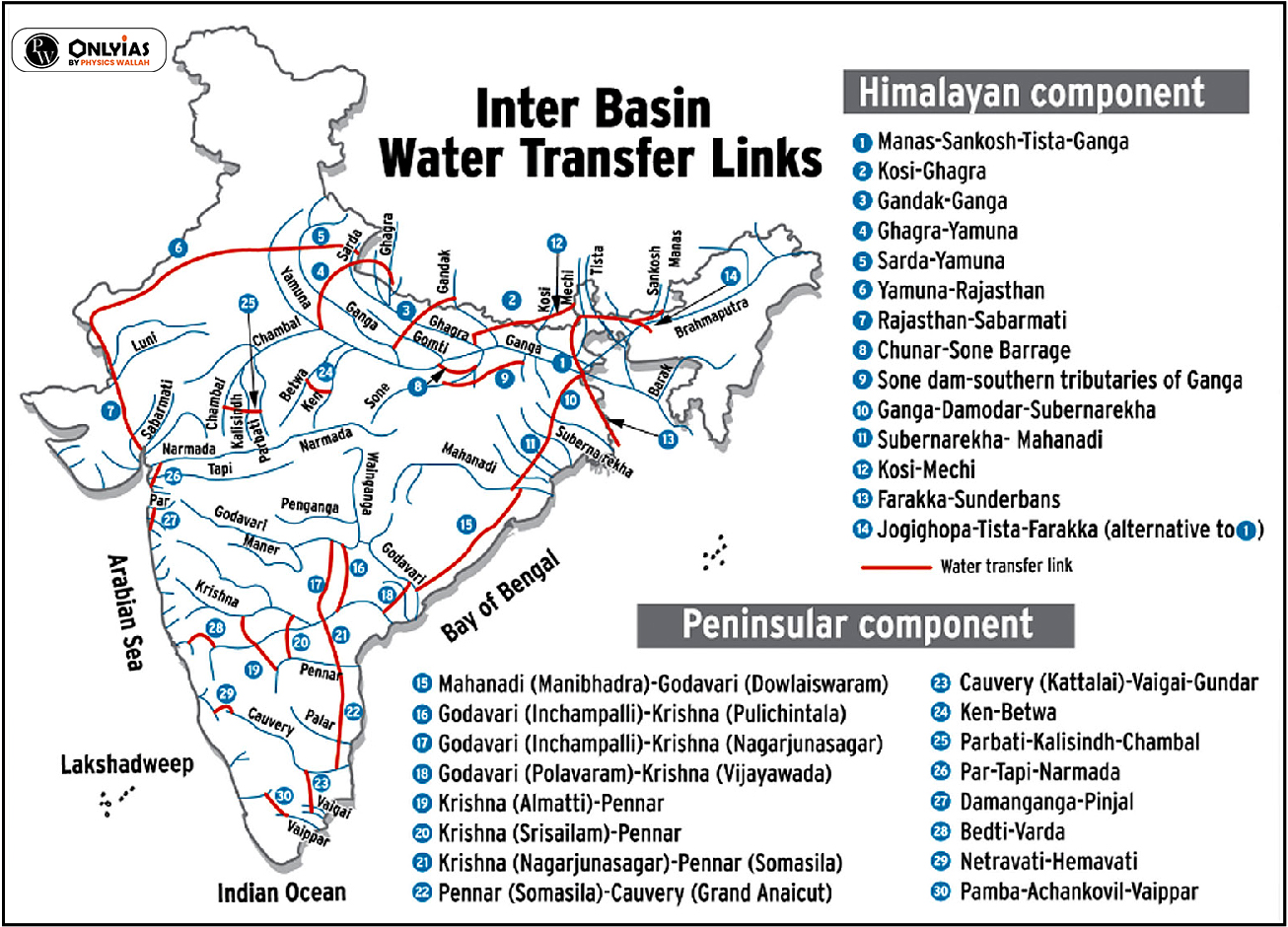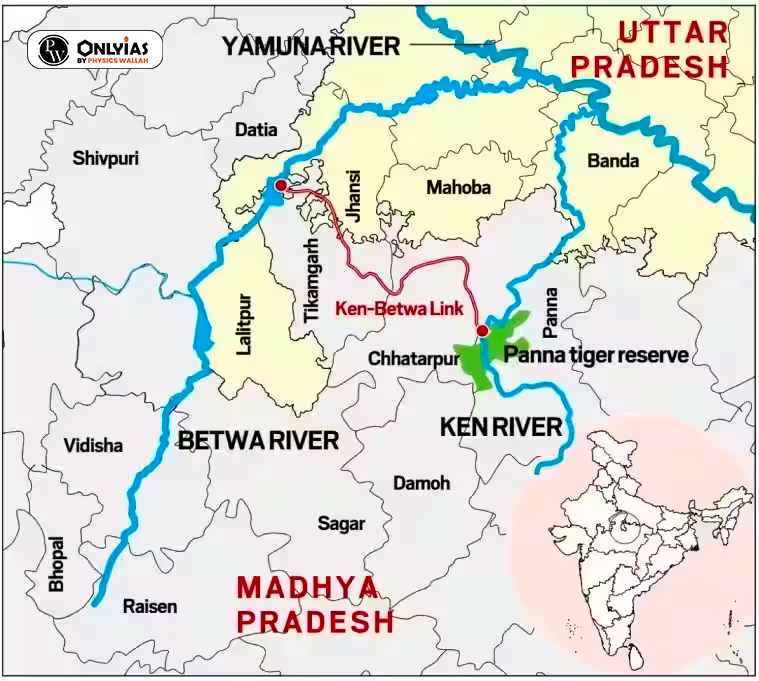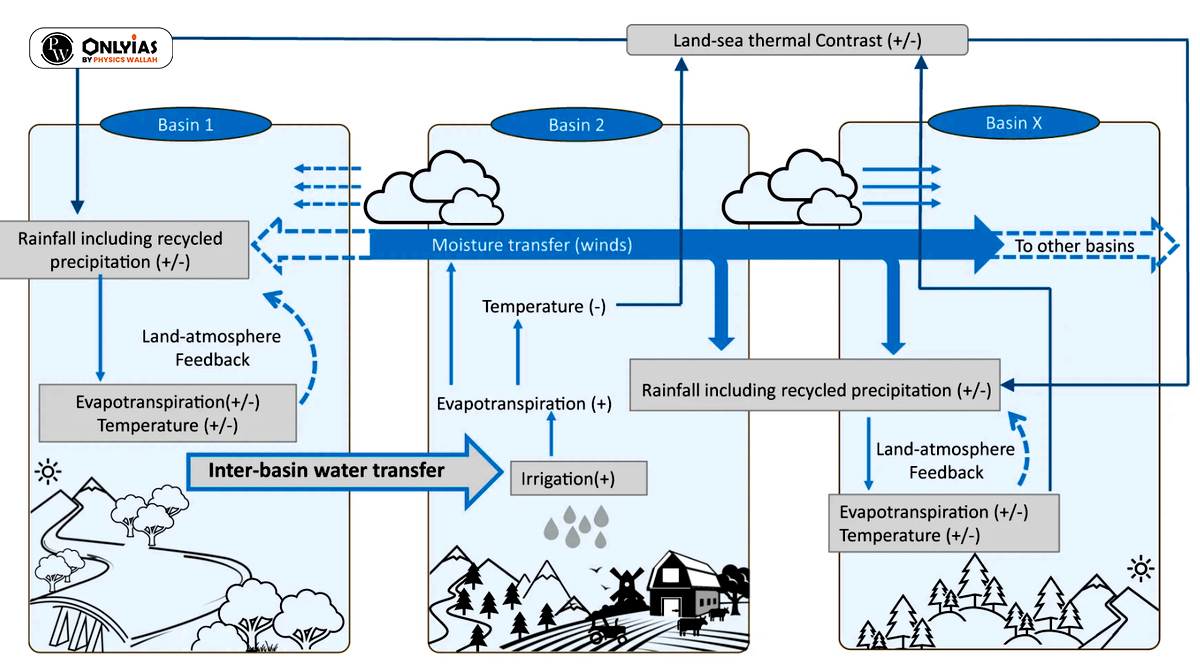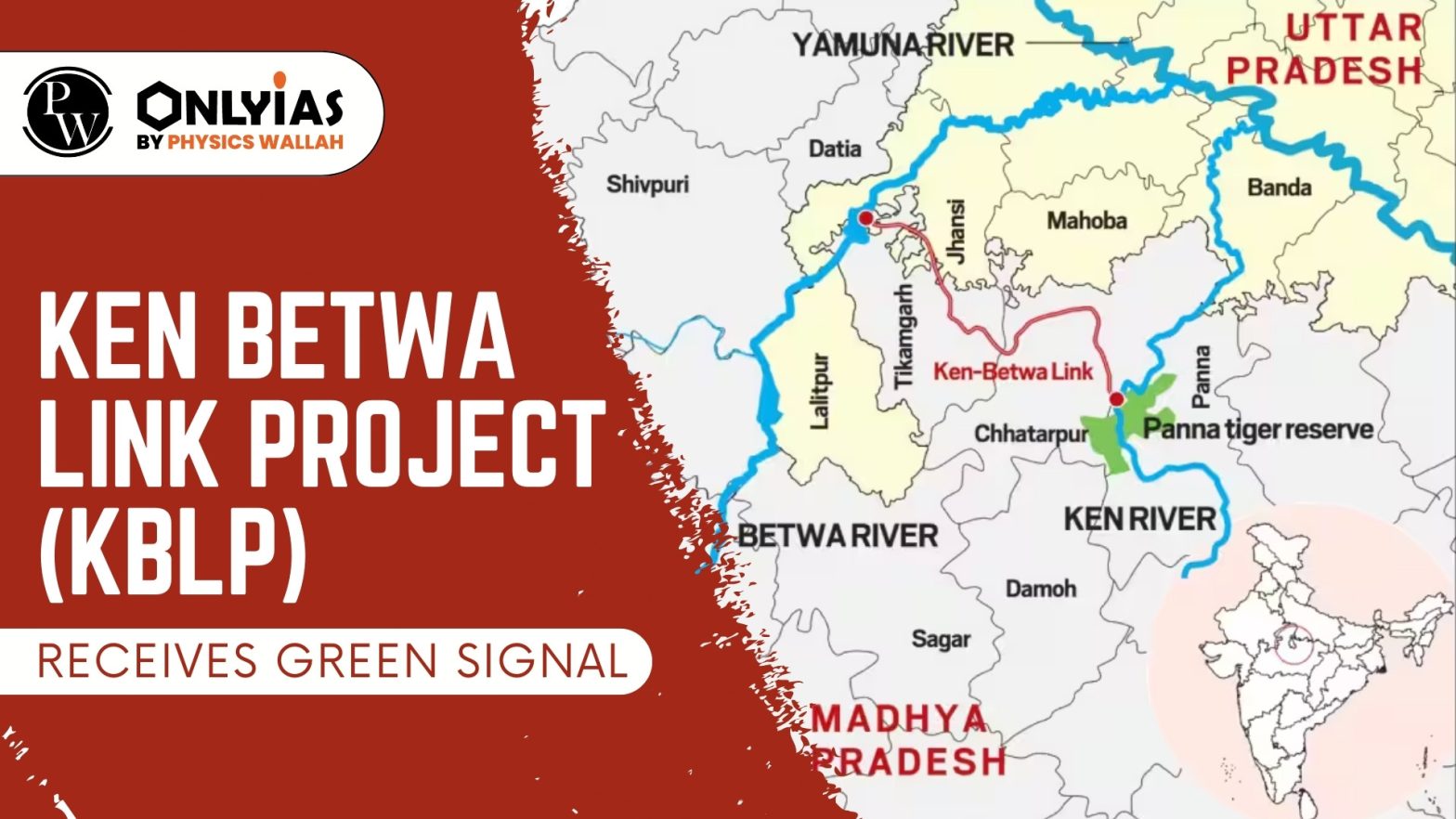Context:
| Relevancy for Prelims: Water Resources in India, Ken Betwa Link Project, National River Linking Project (NRLP), National Water Development Agency (NWDA), National Perspective Plan, and National Board for Wildlife (NBWL).
Relevancy for Mains: Ken Betwa Link Project, Challenges related to Ken Betwa link project, and advantages of interlinking rivers in India. |
Ken Betwa Link Project (KBLP) Approved at Rs 44,605 Cr
- In December 2021, the Union Cabinet approved Ken Betwa Link Project (KBLP) at a total cost of Rs 44,605 crore.
- In this Ken Betwa Link Project, the national and the Madhya Pradesh governments will link the Ken river with the Betwa river so that the latter can water the Bundelkhand region in Uttar Pradesh.
Interlinking of Rivers
- It is the interbasin water transfer from the water surplus rivers to water deficit rivers or regions.
Previous examples of river-linking in India
- Periyar Project: Commissioned in 1895, this project involved the transfer of water from the Periyar basin to the Vaigai basin.
- Similarly, other projects such as Parambikulam Aliyar, Kurnool Cudappah Canal, Telugu Ganga Project, and Ravi-Beas-Sutlej were undertaken.
Global Example
- USA: California’s State Project provides for diversion of water from better-watered northern California to the central and southern part of the state.
- Sri Lanka: Mahaveli-Ganga Project includes several inter-basin transfer links.
|
How many river interlinking projects are there in India?
- Revival of the River-Linking Idea: In the late 1970s, the idea of transferring water from water-rich areas to water-deficit regions was proposed by then Union Irrigation Minister.
- National Perspective Plan (NPP) in 1980: In August 1980, the Ministry of Irrigation formulated the NPP for water resources development, which included inter-basin water transfer in India.
- It comprised two components: Himalayan Rivers Development and Peninsular Rivers Development.
- National Water Development Agency (NWDA) and River Links
- The NWDA identified 30 river-linking projects based on the NPP, categorized into 16 under the Peninsular component and 14 under the Himalayan Component.
- Revival under Atal Bihari Vajpayee Government: The river-linking idea was reinvigorated during the tenure of Atal Bihari Vajpayee’s government. The Ken Betwa Link Project is one such initiative, falling under the Peninsular component.

What is the Ken Betwa Link Project?
- The Ken Betwa Link Project is located in Bundelkhand, a drought-prone region across 13 districts in Uttar Pradesh and Madhya Pradesh.
- Ken Betw Link Project is the first project under the National Perspective Plan for interlinking of rivers.
- Ken Betwa Link Project Aims: To transfer water from Ken river to Betwa river, both tributaries of the Yamuna river.
- Ken Betwa Link Project Phases;
- Phase I: Focus on completing the Daudhan dam complex, including related structures like tunnels, link canal, and power houses.
- Phase II: Involves constructing Lower Orr dam, Bina complex project, and Kotha barrage.
- Expected Benefits of Ken Betwa Link Project are as follows;
- Annual irrigation potential of 10.62 lakh hectares.
- Drinking water supply to approximately 62 lakh people.
- Hydropower generation capacity of 103 MW.

What are the challenges of Ken Betwa link project?
- Legal Approval Questions: The approval by the Standing Committee of the National Board for Wildlife (NBWL) for the Ken Betwa Link Project is questioned, arguing that it hasn’t been proven necessary for wildlife improvement and management as required by Section 35(6) of the Wildlife (Protection) Act, 1972.
- Ultra Vires Approval: The Central Empowered Committee (CEC) of the Supreme Court has deemed the wildlife approval granted by NBWL as ultra vires, suggesting that it exceeded legal authority.
- Ecological and Wildlife Impact: The proposed dam’s potential destructive impact on the ecology and habitats, particularly in the Panna Tiger Reserve and downstream Ken Gharial Sanctuary, is a significant concern related to the Ken Betwa Link Project.
What are the advantages of interlinking rivers in India?
- Hydrological Balance: Interlinking rivers can address India’s hydrological imbalance, efficiently transferring water from flood-prone to drought-prone regions, ensuring better water distribution. Eg’; through Ken Betwa Link Project transfer surplus water from the Ken river in MP to Betwa in UP to irrigate the drought-prone Bundelkhand region.
- Enhanced Inland Navigation: The interlinked river network would improve inland navigation, providing a cost-effective and environmentally friendly mode of transportation, easing pressure on roads and railways.
- Irrigation Benefits: By irrigating around 35 million hectares of water-scarce land in the western peninsula, river interlinking can boost crop outputs, farm incomes, create jobs, and enhance India’s food security.
- Power Generation: Interlinked rivers offer significant potential for power generation, with an estimated total power generation capacity of 34 GW.
- Other Benefits: Interlinking rivers offers substantial benefits such as resolving drinking water scarcity with 90 billion cubic meters, providing 64.8 billion cubic meters for industrial use, supporting fisheries and wildlife survival during water scarcity, and reducing forest fires.
What are the problems with linking rivers in India?
- Impact on Monsoon Cycles: Interlinking river projects can disrupt monsoon cycles, leading to altered precipitation patterns.
- A new study in Nature Communications highlights a 12% decrease in mean rainfall in September across dry arid regions already experiencing water stress due to surplus irrigation from interlinked basins.
- Connected River Basins: The assumption that river basins act as independent entities is debunked.
- The study also emphasizes that river basins are interconnected through feedback loops between land and the atmosphere, and changes in one basin can affect neighboring basins, impacting climate patterns and water availability.
- Ecosystem and Soil Moisture Impact: Excess irrigation from transferred water can lead to drying of soil moisture, contributing to declining rainfall and increased temperatures across central Indian regions.

- Human Impact: The project poses a significant challenge of displacing and disrupting the livelihoods of people, especially those from impoverished and tribal communities residing near forests, necessitating careful rehabilitation efforts.
- Financial Burden: The interlinking project is a high-cost endeavor, with estimates reaching Rs 5,60,000 crore in 2001 for connecting Himalayan and peninsular rivers. Current costs are likely much higher, affecting the overall cost-benefit ratio unfavorably.
- Ecological and Biodiversity Concerns: The merging of rivers could potentially impact biodiversity, as each river has a unique ecology.
- Moreover, considering the pollution levels in many rivers, mixing less polluted rivers with more polluted ones could aggravate environmental concerns.
Also read: The Dynamics of the Kaveri River Water Dispute
Way Forward
- Virtual Water Trade (VWT): Several countries have begun to act early, adopting the VWT route to address worldwide water distress.
- Water-guzzling activities are getting outsourced for production to other countries. Thus, crops, meat, leather, chemicals and industrial goods are imported to ensure a positive water balance.
- Environmental Impact Assessment (EIA): To mitigate the Environmental, Ecological and Climate Change challenges, it is necessary that a broad study by way of environment impact assessment must be conducted and through that study, the government could prepare a crystal-clear road map.
- Comprehensive Water Law: The apprehensions about ill – effects of Inter-linking of Rivers from various sector experts like environment, geography, ecology, archeology and sociology etc. exist till date.
- These apprehensions could be counter by drafting a comprehensive water law covering with the solution and resolution mechanism of all the issues and problems arising out before installing the Interlinking.
- Groundwater Management: India’s water security hinges on nurturing groundwater system. There is a need to identify, protect and enhance recharge areas, use artificial methods, and regulate usage to ensure a sustainable future.
Conclusion
The Ken Betwa Link Project, while holding promises of addressing water scarcity and fostering development, faces challenges such as legal scrutiny, ecological concerns, and potential disruptions to local communities. Balancing its advantages and challenges is crucial for a sustainable and inclusive water management approach in India.
| Attempt the PY Prelims Question
Gadgil Committee Report’ and ‘Kasturirangan Committee Report’, sometimes seen in the news, are related to;
- Constitutional reforms
- Ganga Action Plan
- Linking of rivers
- Protection of Western Ghats
Ans: D |
![]() 11 Oct 2023
11 Oct 2023




